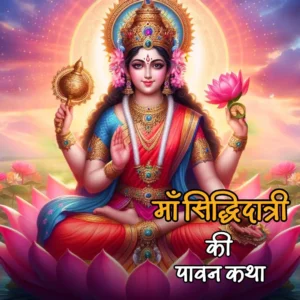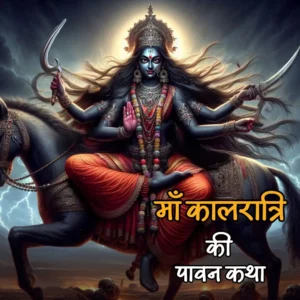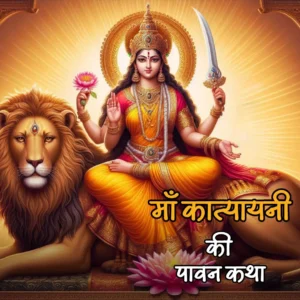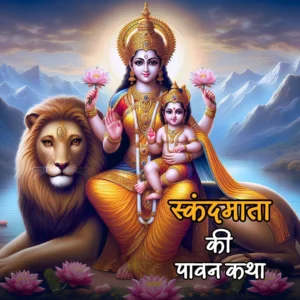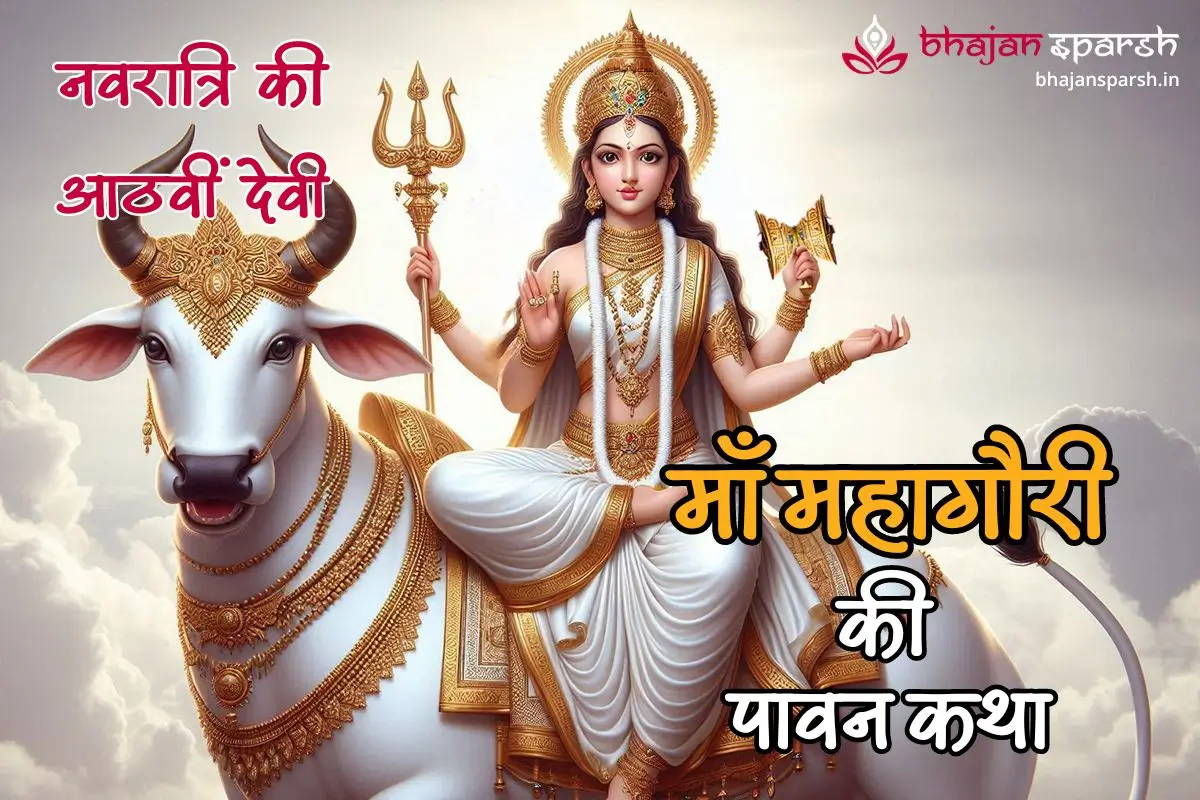
Mahagauri, the eighth form of Goddess Durga, is revered for her purity, serenity, and compassion. Symbolizing peace and wisdom, she is often depicted with a radiant white complexion, riding a white bull. Her four arms represent her divine powers: holding a trident, a damaru (small drum), and bestowing blessings in the Abhayamudra gesture, which signifies fearlessness.
Devotees celebrate Mahagauri especially during the auspicious occasion of Durga Ashtami in Navratri, where they seek her blessings for spiritual growth and tranquility. Her image evokes a sense of calm, and she is considered a protector and nurturer. The worship of Mahagauri encourages us to cultivate purity in our thoughts and actions, making her a beloved figure in Hindu mythology and spirituality.
नवरात्रि की आठवीं देवी – माँ महागौरी की पावन कथा
नवरात्रि का आठवां दिन: महागौरी की महिमा
नवरात्रि के आठवें दिन, जिसे दुर्गा अष्टमी या महाअष्टमी कहा जाता है, मां दुर्गा के आठवें स्वरूप महागौरी की विशेष पूजा-अर्चना की जाती है। महागौरी देवी को पवित्रता, शांति और करुणा की देवी माना जाता है। उनकी छवि अत्यंत शांत, पवित्र और श्वेत है। “महा” का अर्थ है अत्यंत और “गौरी” का अर्थ है श्वेत।
महागौरी के अन्य नाम
महागौरी के सभी वस्त्र और आभूषण श्वेत होते हैं, इसी कारण उन्हें श्वेताम्बरधरा कहा जाता है। उनकी आयु को आठ वर्ष की बालिका के रूप में माना गया है, इसी कारण उन्हें “अष्टवर्षा भवेद् गौरी” कहा जाता है।
महागौरी का दिव्य स्वरूप
महागौरी का वर्ण अत्यंत गोरा है, जिसे शंख, चंद्र और कुंद के फूल के समान उज्ज्वल कहा गया है। उनकी आयु को आठ वर्ष का माना जाता है, इसीलिए उन्हें “अष्टवर्षा भवेद् गौरी” कहा गया है। महागौरी के वस्त्र और आभूषण भी पूरी तरह से श्वेत होते हैं, जो उनकी पवित्रता और दिव्यता को और भी अधिक प्रकट करते हैं।
उनकी चार भुजाएँ हैं, और उनका वाहन वृषभ है। महागौरी के दाहिने ओर ऊपर वाले हाथ में अभय मुद्रा है, जो भक्तों को भयमुक्त करती है, जबकि नीचे वाले दाहिने हाथ में त्रिशूल है, जो उनकी शक्ति का प्रतीक है। बाएँ ओर ऊपर वाले हाथ में डमरू है, जो सृजन और विनाश का संकेत देता है, और नीचे वाले बाएँ हाथ में वर-मुद्रा है, जो भक्तों को आशीर्वाद देने की मुद्रा है।
महागौरी की आकृति अत्यंत शांत और शीतल है। पौराणिक कथाओं के अनुसार, देवताओं की प्रार्थना पर वह हिमालय की श्रृंखलाओं में शाकंभरी देवी के रूप में प्रकट हुई थीं, जो समस्त सृष्टि के कल्याण हेतु आई थीं।
माँ महागौरी के दिव्य रूप की अद्भुत कथाएँ
महागौरी के नाम से जुड़ी दो प्रसिद्ध और रोचक कथाएँ हैं, जो उनके दिव्य रूप को उजागर करती हैं। पहली कथा के अनुसार, जब आदिशक्ति पार्वती ने पर्वतराज हिमालय के घर पुत्री रूप में जन्म लिया, तो उन्होंने भगवान शिव को पति रूप में पाने के लिए देवी पार्वती ने इतनी कठोर तपस्या की कि उनका शरीर काला पड़ गया। उनकी तपस्या से प्रसन्न होकर भगवान शिव ने उन्हें स्वीकार किया और उनके शरीर को गंगा जल से धोया। गंगा जल के स्पर्श से देवी का शरीर विद्युत के समान कांतिमय हो गया और उनका गौर वर्ण प्रकट हुआ। इसी कारण से उन्हें “गौरी” कहा जाने लगा
दूसरी कथा कालरात्रि के रूप से जुड़ी है। जब देवी पार्वती ने शुंभ और निशुंभ नामक दैत्यों का नाश करने के लिए एक भयानक रूप धारण किया, जिसमें उनका रंग अंधकार की तरह काला हो गया। इस डरावने रूप के कारण उन्हें “कालरात्रि” कहा गया। इस रूप में उन्होंने शुंभ-निशुंभ और उनकी विशाल सेना को पराजित कर दिया और देवताओं को फिर से स्वर्ग का अधिकार दिलाया।
जब देवी कालरात्रि अपने कार्य को पूर्ण कर कैलाश पर अपने पति भगवान शिव के पास लौटीं, तो शिवजी ने उनकी काली त्वचा को देखकर उन्हें उपहास में “काली” कहकर संबोधित किया। यह सुनकर देवी ने सोचा कि उनका यह रूप केवल राक्षसों का विनाश करने के लिए था, और अब उन्हें अपने सुंदर स्वरूप में लौट जाना चाहिए। उन्होंने अपनी काली त्वचा को त्यागने के लिए कई प्रयास किए, लेकिन सफल नहीं हुईं।
अंततः उन्होंने ब्रह्मा जी की तपस्या करने का निश्चय किया ताकि वह उन्हें इसका समाधान बता सकें। उनकी कठोर तपस्या से प्रसन्न होकर ब्रह्मा जी ने उन्हें मानसरोवर झील में स्नान करने का सुझाव दिया। देवी ने ऐसा ही किया, और स्नान के बाद उनकी पूर्व की उज्ज्वल श्वेत त्वचा वापस लौट आई। इसी कारण उन्हें “कौशिकी” कहा गया।
एक बार देवी कौशिकी ने एक दिव्य नदी में स्नान किया, जिससे उनकी त्वचा और भी अधिक कांतिमान हो गई, और इसी कारण उनका नाम “महागौरी” पड़ा। महागौरी का यह स्वरूप शांति, पवित्रता और दिव्यता का प्रतीक है, जो उनके श्वेत वर्ण से प्रकट होता है।
कैसे सिंह बना देवी महागौरी का दिव्य वाहन?
महागौरी से जुड़ी एक अन्य कथा भी प्रचलित है। कहा जाता है कि जब देवी उमा (पार्वती) भगवान शिव को पति रूप में पाने के लिए कठोर तपस्या कर रही थीं, तब एक भूखा सिंह भोजन की तलाश में वहां पहुंचा। देवी को तपस्या करते हुए देखकर उसकी भूख और भी बढ़ गई, लेकिन उसने धैर्य रखा और देवी के तप से उठने का इंतजार करने लगा। इस इंतजार में सिंह इतना कमजोर हो गया कि वह वहां बैठा-बैठा धीरे-धीरे तपस्वी जैसा लगने लगा।
जब देवी उमा ने अपनी तपस्या पूरी की और अपनी आंखें खोलीं, तो उन्होंने सिंह की दयनीय हालत देखी। सिंह की इस धैर्यपूर्ण प्रतीक्षा और उसके समर्पण को देखकर देवी को उस पर दया आ गई। उन्होंने उसे अपनी सवारी बनाने का निर्णय लिया, क्योंकि एक प्रकार से सिंह ने भी तपस्या जैसी साधना की थी। इसलिए, देवी महागौरी का वाहन केवल वृषभ (बैल) ही नहीं, बल्कि सिंह भी माना जाता है।
माँ महागौरी का प्रिय रंग और फूल
माँ महागौरी को सफेद रंग बेहद प्रिय है, और उनका प्रिय फूल मोगरा है। इस दिन की पूजा में मोगरे के फूलों का शामिल होना बहुत शुभ माना जाता है।
माँ महागौरी का प्रिय भोग
माँ महागौरी का प्रिय भोग नारियल है, इसलिए अष्टमी के दिन नारियल से बना भोग जैसे नारियल की बर्फी या लड्डू चढ़ाना बहुत शुभ माना गया है।
महागौरी का मंत्र
ॐ देवी महागौर्यै नमः॥
या देवी सर्वभूतेषु माँ गौरी रूपेण संस्थिता।
नमस्तस्यै नमस्तस्यै नमस्तस्यै नमो नम:॥
श्वेते वृषे समारुढा श्वेताम्बरधरा शुचिः |
महागौरी शुभं दद्यान्महादेवप्रमोददा ||
Eighth Day of Navratri: The Glory of Mahagauri
On the eighth day of Navratri, called Durga Ashtami or Maha Ashtami, special prayers are offered to Mahagauri, the eighth form of Maa Durga. Mahagauri Devi is considered the goddess of purity, peace and compassion. Her image is extremely calm, holy and white. “Maha” means extremely and “Gauri” means white.
Other names of Mahagauri
All the clothes and ornaments of Mahagauri are white, that is why she is called Shwetambardhara. Her age is considered to be that of an eight-year-old girl, that is why she is called “Ashtvarsha Bhaved Gauri”.
Divine Form of Mahagauri
Mahagauri has a very fair complexion, which is said to be as bright as the conch, moon and the Kunda flower. Her age is considered to be eight years, that is why she is called “Ashtavarsha Bhaved Gauri”. Mahagauri’s clothes and ornaments are also completely white, which further reveals her purity and divinity.
She has four arms, and her vehicle is a bull. Mahagauri’s upper right hand has Abhaya Mudra, which frees the devotees from fear, while the lower right hand holds a trident, which is a symbol of her power. The upper left hand holds a damru, which indicates creation and destruction, and the lower left hand holds Var-Mudra, which is a posture of blessing the devotees.
Mahagauri’s figure is very calm and cool. According to mythology, on the prayers of the gods, she appeared in the Himalayan ranges in the form of Shakambhari Devi, who came for the welfare of the entire creation.
Amazing stories of the divine form of Maa Mahagauri
There are two famous and interesting stories associated with the name of Mahagauri, which highlight her divine form. According to the first story, when Adishakti Parvati was born as a daughter in the house of Parvataraja Himalaya, she performed such a rigorous penance to get Lord Shiva as her husband that her body turned black. Pleased with her penance, Lord Shiva accepted her and washed her body with Ganga water. With the touch of Ganga water, the body of the goddess became as luminous as electricity and her fair complexion appeared. For this reason she came to be called “Gauri”.
The second story is associated with the form of Kaalratri. When Goddess Parvati assumed a terrifying form to destroy the demons named Shumbh and Nishumbh, in which her color became as black as darkness. Due to this scary form, she was called “Kaalratri”. In this form, she defeated Shumbh-Nishumbh and their huge army and gave the gods the right to heaven again.
When Goddess Kalaratri returned to her husband Lord Shiva at Kailash after completing her task, Shiva mocked her by calling her “Kali” on seeing her black skin. Hearing this, the Goddess thought that she had this form only to destroy demons, and now she should return to her beautiful form. She made many attempts to shed her black skin, but was unsuccessful.
Finally, she decided to perform penance to Lord Brahma so that he could tell her the solution. Pleased with her rigorous penance, Lord Brahma suggested her to take a bath in the Manasarovar lake. The Goddess did so, and after the bath, her earlier radiant white skin returned. This is why she was called “Kaushiki”.
Once Goddess Kaushiki took a bath in a divine river, which made her skin even more radiant, and this is why she was named “Mahagauri”. This form of Mahagauri symbolizes peace, purity and divinity, which is reflected in her white complexion.
How lion became the divine vehicle of Goddess Mahagauri?
Another legend related to Mahagauri is also popular. It is said that when Goddess Uma (Parvati) was performing rigorous penance to get Lord Shiva as her husband, a hungry lion reached there in search of food. Seeing the Goddess performing penance, his hunger increased even more, but he kept patience and waited for the Goddess to wake up from her penance. In this wait, the lion became so weak that he gradually started looking like an ascetic sitting there.
When Goddess Uma completed her penance and opened her eyes, she saw the pitiable condition of the lion. Seeing this patient wait of the lion and his dedication, the Goddess felt pity on him. She decided to make him her ride, because in a way the lion had also performed penance-like sadhana. Therefore, the vehicle of Goddess Mahagauri is considered to be not only Vrishabha (bull) but also the lion.
Mother Mahagauri’s favorite color and flower
Maa Mahagauri loves white color very much, and her favorite flower is Mogra. The inclusion of Mogra flowers in the worship of this day is considered very auspicious.
Maa Mahagauri’s favorite offering
Mother Mahagauri’s favorite offering is coconut, so offering coconut bhog like coconut barfi or laddu on Ashtami is considered very auspicious.
Mantra of Mahagauri
Om Devi Mahagauryai Namah
Ya Devi Sarvabhuteshu Maa Gauri Rupena Sansthitā.
Namastasyai Namastasyai Namastasyai Namo Namah.
Shvete Vrishhe Samarudha Shvetambaradhara Shuchiḥ.
Mahagauri Shubham Dadyan Mahadevapramodada.
નવરાત્રીનો આઠમો દિવસ: મહાગૌરીનો મહિમા
નવરાત્રિના આઠમા દિવસે, જેને દુર્ગા અષ્ટમી અથવા મહાઅષ્ટમી કહેવામાં આવે છે, મા દુર્ગાના આઠમા સ્વરૂપ મહાગૌરીની વિશેષ પૂજા કરવામાં આવે છે. મહાગૌરી દેવીને પવિત્રતા, શાંતિ અને કરુણાની દેવી માનવામાં આવે છે. તેમની છબી અત્યંત શાંતિપૂર્ણ, શુદ્ધ અને સફેદ છે. ‘મહા’ એટલે અત્યંત અને ‘ગૌરી’ એટલે સફેદ.
મહાગૌરીના અન્ય નામો
મહાગૌરીના તમામ વસ્ત્રો અને આભૂષણો સફેદ છે, તેથી જ તેમને શ્વેતામ્બરધરા કહેવામાં આવે છે. તેમની ઉંમર આઠ વર્ષની છોકરી ગણવામાં આવે છે, તેથી જ તેમને “અષ્ટવર્ષા ભવેદ ગૌરી” કહેવામાં આવે છે.
મહાગૌરીનું દિવ્ય સ્વરૂપ
મહાગૌરીનો રંગ અત્યંત ગોરો છે, જે શંખ, ચંદ્ર અને કુંડના ફૂલ જેવો તેજસ્વી કહેવાય છે. તેમની ઉંમર આઠ વર્ષની માનવામાં આવે છે, તેથી જ તેમને “અષ્ટવર્ષા ભવેદ ગૌરી” કહેવામાં આવે છે. મહાગૌરીના કપડાં અને આભૂષણો પણ સંપૂર્ણપણે સફેદ છે, જે તેમની પવિત્રતા અને દિવ્યતા દર્શાવે છે.
તેમની પાસે ચાર હાથ છે અને તેમનું વાહન બળદ છે. મહાગૌરીના ઉપરના જમણા હાથમાં અભય મુદ્રા છે, જે ભક્તોને ભયમાંથી મુક્ત કરે છે, જ્યારે નીચલા જમણા હાથમાં ત્રિશૂળ છે, જે તેમની શક્તિનું પ્રતીક છે. ઉપરના ડાબા હાથમાં ડમરુ છે, જે સર્જન અને વિનાશનું સૂચન કરે છે અને નીચેના ડાબા હાથમાં વર-મુદ્રા છે, જે ભક્તોને આશીર્વાદ આપવાની મુદ્રા છે.
મહાગૌરીની આકૃતિ ખૂબ જ શાંત અને ઠંડી છે. પૌરાણિક કથાઓ અનુસાર, દેવતાઓની પ્રાર્થના પર, તે હિમાલયની પર્વતમાળામાં દેવી શાકંભરીના રૂપમાં પ્રગટ થઈ હતી, જે સમગ્ર સૃષ્ટિના કલ્યાણ માટે આવી હતી.
માતા મહાગૌરીના દિવ્ય સ્વરૂપની અદ્ભુત વાર્તાઓ
મહાગૌરીના નામ સાથે બે પ્રસિદ્ધ અને રસપ્રદ કથાઓ જોડાયેલી છે, જે તેમના દિવ્ય સ્વરૂપને ઉજાગર કરે છે. પ્રથમ કથા અનુસાર, જ્યારે આદિશક્તિ પાર્વતીનો જન્મ પર્વત રાજા હિમાલયની પુત્રી તરીકે થયો હતો, ત્યારે ભગવાન શિવને તેના પતિ તરીકે પ્રાપ્ત કરવા માટે, દેવી પાર્વતીએ એટલી કઠોર તપસ્યા કરી કે તેનું શરીર કાળું થઈ ગયું. તેમની તપસ્યાથી પ્રસન્ન થઈને ભગવાન શિવે તેમનો સ્વીકાર કર્યો અને તેમના શરીરને ગંગાજળથી ધોઈ નાખ્યું. ગંગાજળના સ્પર્શથી દેવીનું શરીર વિદ્યુત જેવું તેજોમય બની ગયું અને તેમનો ગોરો રંગ દેખાયો. આ કારણોસર તેમને “ગૌરી” કહેવામાં આવે છે.
બીજી કથા કાલરાત્રીના સ્વરૂપ સાથે સંબંધિત છે. જ્યારે દેવી પાર્વતીએ શુમ્ભ અને નિશુમ્ભ નામના રાક્ષસોનો નાશ કરવા માટે ભયંકર રૂપ ધારણ કર્યું, જેમાં તેમનો રંગ અંધકાર જેવો કાળો થઈ ગયો. આ ભયાનક દેખાવને કારણે તેમને “કાલરાત્રી” કહેવામાં આવતું હતું. આ સ્વરૂપમાં તેમણે શુંભ-નિશુમ્ભ અને તેની વિશાળ સેનાને હરાવી દેવતાઓને ફરીથી સ્વર્ગનો અધિકાર આપ્યો.
જ્યારે દેવી કાલરાત્રી પોતાનું કાર્ય પૂર્ણ કરીને કૈલાસ પર તેમના પતિ ભગવાન શિવ પાસે પરત ફર્યા, ત્યારે ભગવાન શિવે તેમની કાળી ચામડી જોઈને તેમને “કાલી” કહીને સંબોધન કર્યું. આ સાંભળીને દેવીએ વિચાર્યું કે તેમનું સ્વરૂપ માત્ર રાક્ષસોનો નાશ કરવા માટે છે અને હવે તેમણે તેમના સુંદર સ્વરૂપમાં પાછા ફરવું જોઈએ. તેઓએ તેમની કાળી ચામડી છોડવા માટે ઘણા પ્રયત્નો કર્યા, પરંતુ સફળ થઈ નહીં.
આખરે તેઓણે ભગવાન બ્રહ્માની તપસ્યા કરવાનું નક્કી કર્યું જેથી તે તેમને ઉપાય જણાવી શકે. તેમની કઠોર તપસ્યાથી પ્રસન્ન થઈને ભગવાન બ્રહ્માએ તેમને માનસરોવર તળાવમાં સ્નાન કરવાનું સૂચન કર્યું. દેવીએ તેમ કર્યું, અને સ્નાન કર્યા પછી તેમની ભૂતપૂર્વ તેજસ્વી સફેદ ચામડી પાછી આવી. આ કારણથી તેમને ‘કૌશિકી’ કહેવામાં આવતા હતા.
એકવાર દેવી કૌશિકીએ એક દૈવી નદીમાં સ્નાન કર્યું, જેનાથી તેમની ત્વચા વધુ તેજસ્વી બની ગઈ, અને તેથી તેમનું નામ “મહાગૌરી” પડ્યું. મહાગૌરીનું આ સ્વરૂપ શાંતિ, પવિત્રતા અને દિવ્યતાનું પ્રતીક છે, જે તેના સફેદ રંગમાં પ્રતિબિંબિત થાય છે.
સિંહ કેવી રીતે બન્યો દેવી મહાગૌરીનું દિવ્ય વાહન?
મહાગૌરી સાથે જોડાયેલી બીજી વાર્તા પણ પ્રચલિત છે. એવું કહેવાય છે કે જ્યારે દેવી ઉમા (પાર્વતી) ભગવાન શિવને તેમના પતિ તરીકે મેળવવા માટે કઠોર તપસ્યા કરી રહી હતી, ત્યારે એક ભૂખ્યો સિંહ ખોરાકની શોધમાં ત્યાં પહોંચ્યો. દેવીને તપસ્યા કરતી જોઈને તેની ભૂખ વધુ વધી ગઈ, પરંતુ તે ધીરજ રાખ્યો અને દેવી તપસ્યામાંથી જાગે તેની રાહ જોવા લાગ્યો. આ રાહમાં સિંહ એટલો નબળો પડી ગયો કે ત્યાં બેસીને તે ધીરે ધીરે સંન્યાસી જેવો દેખાવા લાગ્યો.
જ્યારે દેવી ઉમાએ તેની તપસ્યા પૂર્ણ કરી અને તેની આંખો ખોલી ત્યારે તેમણે સિંહની દયનીય સ્થિતિ જોઈ. સિંહના દર્દીની રાહ જોઈને અને તેનું સમર્પણ જોઈને દેવીને તેના પર દયા આવી. તેમણે તેને પોતાનું વાહન બનાવવાનું નક્કી કર્યું, કારણ કે એક રીતે, સિંહે પણ તપસ્યા જેવી સાધના કરી હતી. તેથી, દેવી મહાગૌરીનું વાહન માત્ર વૃષભ (બળદ) જ નહીં પરંતુ સિંહ પણ માનવામાં આવે છે.
માતા મહાગૌરીનો પ્રિય રંગ અને ફૂલ
માતા મહાગૌરીને સફેદ રંગ ખૂબ જ પસંદ છે અને તેમનું પ્રિય ફૂલ મોગરા છે. આ દિવસની પૂજામાં મોગરાના ફૂલનો સમાવેશ કરવો ખૂબ જ શુભ માનવામાં આવે છે.
માતા મહાગૌરીની પ્રિય ભોગ
દેવી મહાગૌરીનો પ્રિય પ્રસાદ નારિયેળ છે, તેથી અષ્ટમીના દિવસે નારિયેળ આધારિત પ્રસાદ કે નાળિયેર બરફી અથવા લાડુ ચઢાવવાને ખૂબ જ શુભ માનવામાં આવે છે.
મહાગૌરીનો મંત્ર
ૐ દેવી મહાગૌર્યૈ નમઃ
યા દેવી સર્વભૂતેષુ માં ગૌરી રૂપેણ સંસ્થિતા।
નમસ્તસ્યૈ નમસ્તસ્યૈ નમસ્તસ્યૈ નમો નમઃ।
શ્વેતે વૃષે સમારૂઢા શ્વેતામ્બરધરા શુચિઃ।
મહાગૌરી શુભં દદ્યાની મહાદેવપ્રમોદદા।

